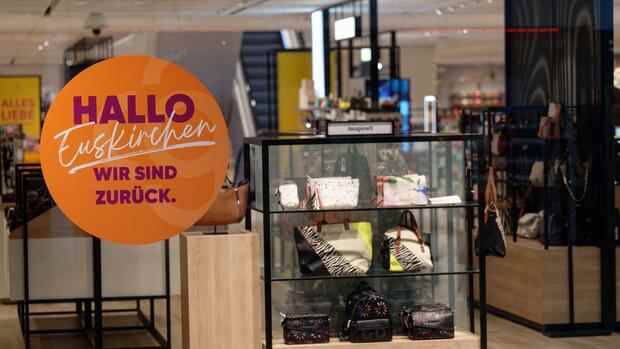Euskirchen The euphoria was great last October. The Karstadt Kaufhof department store chain had promised a new start under the Galeria brand and presented three pilot branches: Kleve as a “local forum”, Kassel as a “regional magnet” and Frankfurt as a “cosmopolitan city store”.
50 to 60 houses should be completely rebuilt, the rest of the 131 branches should at least be adapted. “We now have to roll out quickly,” said Galeria boss Miguel Müllenbach at the time.
But it took six months until the first house based on the new concept was opened. On Thursday, the store in Euskirchen near Bonn will open to customers again after months of renovation. It’s not really spectacular – a local supplier on a slightly reduced sales area of 6200 square meters.
Not too many other new houses will follow this year. Fulda is reopened after a complete renovation, the building on Munich’s Marienplatz is at least modernized considerably. In addition, there are two branches in shopping centers, one of them in the Centro in Oberhausen.
Top jobs of the day
Find the best jobs now and
be notified by email.
Experts had already suspected that it would be difficult to implement the ambitious plans when they were announced in autumn. “The concept is fundamentally interesting, but implementing it is a Herculean task,” said Jörg Funder, a trade expert from Worms University, to the Handelsblatt at the time. “There is a lot of expectation from customers, but they will not be able to convert all the houses fast enough.”
Not too many other new houses will follow this year.
(Photo: dpa)
The lack of speed threatens to become the greatest risk of the restart as “Galeria 2.0”, the experts explained. The lack of money is crucial. The estimated investment sum of 400 million euros is far too low, said trade expert Gerrit Heinemann from the Niederrhein University of Applied Sciences.
Missing building materials slow down the restart of Galeria
But that’s not the limiting factor at the moment. “We have the capital, but we don’t get the materials for the conversion,” says Galeria boss Müllenbach to the Handelsblatt. The general scarcity of building materials is slowing down the restart.
Even the choice of Euskirchen as the first branch to implement the “Galeria 2.0” concept is based less on a strategic approach than on pure necessity. The branch was affected by the flood disaster last summer and had to be renovated anyway. The basement was completely under water, the ground floor up to a height of one meter.
“We had to let the basement dry out for three months,” says branch manager Hans-Peter Neusser. It had been gutted down to the foundations and the rubble had to be removed with an excavator. Now the house shines with new floors, new furniture and much more natural light – paid for in large part by insurance money.
“We have to get into the rollout quickly now.”
(Photo: dpa)
The announced relaunch of the online shop has not yet been completed either. “We continue to work on the completion with great energy,” said Müllenbach during a first tour of Euskirchen. It was certainly not helpful that the digital boss Andreas Hink, who was brought in with a lot of advance praise in 2020, left the company again in January. Nevertheless, Müllenbach announces that the new online shop will “set standards across the industry”.
The company reports that the three pilot branches have proven themselves on the market. This applies in particular to Kassel and Kleve. Frankfurt is still suffering from the lack of foreign tourists, on whom special hopes were placed when it came to the concept and range of products.
Customer frequency is still up to 25 percent below 2019
Overall, customer frequency in the Galeria branches is still 20 to 25 percent below the values of 2019, the Galeria boss admits. While the consequences of the pandemic had depressed sales for a long time, it is now the war in Ukraine that is weighing on consumer sentiment.
In addition, the entire trade continues to suffer from severely disrupted supply chains. According to the market, around 20 to 30 percent of the goods ordered cannot be delivered at the agreed time, and many products are not available at all. Many retailers are currently controlling their assortment according to the availability of the goods.
>> Read here: Investments in supply chains: Amazon wants to deliver more reliably again
But Galeria doesn’t want to let this spoil the new start, owner René Benko still has ambitious plans for the chain. “Together with our owner, we are in the process of pushing ahead with some very large developments that not only literally mean the creation of large branches, but also a significant upgrading of the respective city center,” says Müllenbach.
At the reopening of the converted branch in Frankfurt, the Galeria owner was confident.
(Photo: imago images/STAR-MEDIA)
What he actually means by that is a departure from the classic department store. In large cities, previous houses are to be converted into mixed-use properties, with apartments, offices – and a galeria branch with significantly less sales space.
The hope is that this will significantly increase the profitability of the property. And that is in the spirit of the owner, Benko. After all, his company Signa still owns 25 of the once proud department stores.
More: “It’s a scandal” – Experts criticize the second state loan for Galeria
